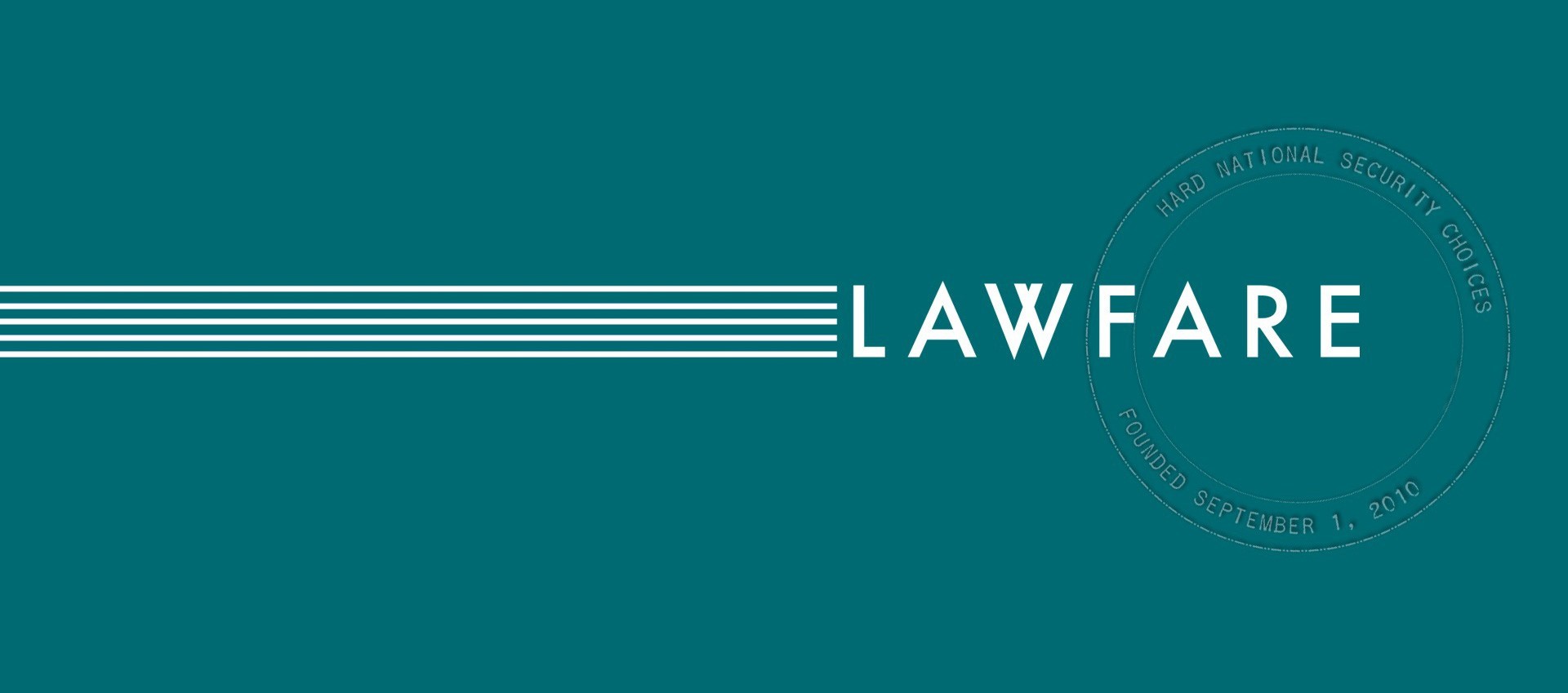The Supreme Court’s Cert Grant in the Travel Ban Cases: A Guide for the Perplexed
Today the Supreme Court announced in a per curiam decision that it will hear the travel ban cases in October. But its decision granting certiorari and staying the injunctions in part is clearly by itself a major ruling. Here are the key points and some nuances for the perplexed.
Published by The Lawfare Institute
in Cooperation With

Today the Supreme Court announced in a per curiam decision that it will hear the travel ban cases in October. But its decision granting certiorari and staying the injunctions in part is clearly by itself a major ruling. Here are the key points and some nuances for the perplexed.
Carving Up the Injunctions
The Court’s most important move was to carve up the preliminary injunctions that the government is challenging: unanimously, the Court lifted the injunctions as to "foreign nationals who lack any bona fide relationship with a person or entity in the United States." That's with respect to Section 2(c) of the Executive Order, which restricts entry by immigrants from the named six countries, and also Section 6(a), which suspends refugee admissions and imposes a dramatically smaller cap on the number of refugees who may come in.
The practical upshot of this carve-up is different for immigrants and refugees, who are differently situated with respect to the Executive Order. As Marty Lederman points out, the Court’s ruling is a “huge victory for the plaintiffs” in the sense that the injunctions remain in place with respect to those connected somehow to people in the country and protect even those aliens not directly involved in these suits—as long as they have the requisite relationships with U.S. persons or entities. On the other hand, I see the ruling as a big blow for refugees, who by dint of their situation often do not have the kind of nexus that is now required for them to enter the country.
But the carve-up also matters because it reveals the Court’s skepticism about the more expansive standing arguments put forward by plaintiffs in both the IRAP and Hawaii cases. Remember that the plaintiffs argued, and the Fourth Circuit agreed (the Ninth Circuit didn’t reach the question), that the travel ban actually affects all U.S. Muslims to the extent it sends a state-sanctioned message condemning their religion. That’s what Chief Judge Roger Gregory of the Fourth Circuit described as the “marginalization and exclusion” of Muslims around the United States. By breaking up the injunction the way it did, and limiting its protection to U.S. families and people with U.S. connections who would be affected by the Executive Order, the Supreme Court is declaring that, at the very least, those broadly-stated harms were not enough to tip the equities in favor of leaving the injunctions fully intact until the Court can fully consider the matter.
"Bona Fide Relationship"
The Court goes so far as to define what it means when it says the stay is lifted only as to aliens with a “bona fide relationship with a person or entity in the United States.” That's an interesting move, and the Court frames its decision to provide this clarification in a way that emphasizes that the lower courts overreached in upholding injunctions that "reach[ed] much further" than mitigating "concrete burdens" that fall on plaintiffs John Doe (Fourth Circuit) and Dr. Elshikh and Hawaii (Ninth Circuit).
The Court’s pragmatic “how-to” for properly applying its injunction carve-up is worth quoting in full:
For individuals, a close familial relationship is required. A foreign national who wishes to enter the United States to live with or visit a family member, like Doe’s wife or Dr. Elshikh’s mother-in-law, clearly has such a relationship. As for entities, the relationship must be formal, documented, and formed in the ordinary course, rather than for the purpose of evading EO–2. The students from the designated countries who have been admitted to the University of Hawaii have such a relationship with an American entity. So too would a worker who accepted an offer of employment from an American company or a lecturer invited to address an American audience. Not so someone who enters into a relationship simply to avoid §2(c): For example, a nonprofit group devoted to immigration issues may not contact foreign nationals from the designated countries, add them to client lists, and then secure their entry by claiming injury from their exclusion.
Mootness
The consolidated cases might very well be moot by the time the Court hears them in October. As if to eliminate any doubt that the case may end up being decided on mootness grounds, the Court added a question to those to be argued: “Whether the challenges to §2(c) became moot on June 14, 2017.”
The choice of date is significant. On June 14, which marked 90 days after the effective date of the order, Trump issued a presidential memorandum amending the executive order in light of the Fourth and Ninth Circuit decisions and instructing federal agencies to begin the internal review of vetting procedures no longer stayed because of the Ninth Circuit's decision (issued June 12) to narrow the Hawaii injunction. Trump made the move to tamp down on mootness concerns, but Hawaii argued last week that this memorandum itself rendered the travel ban—and the Supreme Court's involvement—unnecessary. It’s a line of argument the Court is now explicitly taking up.
The Court pointedly states in its opinion that “we fully expect that the relief we grant today will permit the Executive to conclude its internal work and provide adequate notice to foreign governments within the 90-day life of §2(c).” That 90-day window will have run by the time the Court hears the case during the first October session.
Justice Thomas’s Opinion
Justice Thomas wrote an opinion, joined by Justices Alito and Gorsuch—but not Justice Kennedy or Chief Justice Roberts—dissenting from the majority opinion to the extent it did not stay the preliminary injunctions in full. Thomas’s opinion is important in a couple respects.
First, it makes clear that at least three members of the Court are inclined to take a hard line against judicial second-guessing of the president’s national security determinations for purposes of immigration policy. That said, consider how the opinion chooses to characterize the competing interests. He says that, in deciding whether to grant the stays in full, “the Government’s interest in preserving national security” should win out “against the hardships caused to respondents by temporary denials of entry into the country.” In other words, the three Justices buy the government’s insistence that the travel ban isn’t a travel ban at all, but a temporary pause until the administration can work out a better plan. Given this language, I don’t think it’s fair to assume the Justices would come to the same place if the policy were something harsher than a temporary measure. Note that the majority opinion is careful not to use language setting out the competing interests in a way that minimizes the burdens allegedly imposed by the Executive Order—to decide how the equities tip, the majority instead sticks to consideration of the U.S. nexus of the aliens in question.
Second, Justice Thomas’s opinion matters because of how he reads the majority opinion: “I agree with the Court’s implicit conclusion that the Government has made a strong showing that it is likely to succeed on the merits—that is, that the judgments below will be reversed.” Justice Thomas’s interpretation is obviously not dispositive with respect to how the majority opinion should, in fact, be read; my own sense is that the majority was rather careful not to do more than signal its inclination to accept a conventional definition of standing and the quite persuasive argument for the travel ban’s mootness. But the administration will certainly be gratified by the minority’s view of the majority’s view of the matter.
Who Won?
This morning, President Trump informed the American people that the Supreme Court just handed him a win:
Very grateful for the 9-O decision from the U. S. Supreme Court. We must keep America SAFE!
— Donald J. Trump (@realDonaldTrump) June 26, 2017
And he’s not entirely alone. For example, in contrast with Lederman, Adrian Vermeule has described the opinion as a "victory" for the Trump administration.
Some of the divergence we are seeing is par for the course when it comes to partial stays. But most of it has to do with the two very different baselines the two sides are using in assessing the significance of the travel ban litigation. The answer is that neither side won—but if you have to pick a side, this is a government loss.
For anyone whose chief concern throughout this litigation has been the significance of the injunctions for the courts’ willingness to second-guess executive power in national security cases, the Supreme Court's opinion today might seem positive for the administration because of its measured tone. In addition, the liberal Justices did not write separately to counter Justice Thomas's points or to share the lower courts’ indignation. But it’s a mistake to read too much into the difference between the language of the Supreme Court and the opinions of the lower courts.
The Court has a distinct purpose here—it is punting the ball until October, when the case will probably be moot and the travel ban will have run its course. To focus too much on all the things the Court did not comment on is to misunderstand the limited nature of the conventional stay analysis. Overall, the majority was careful to stick to rendering only enough analysis to make a temporary decision on the equities of granting versus denying the requested stays, and the principles it used to carve up the injunction as it did—a focus on concrete harms, and the idea that the executive's power to enforce Section 2(c) is at its "peak when there is no tie between the foreign national and the United States”—are not at all radical for purposes of according equitable relief.
If the right yardstick to use is whether Trump got what he wanted since issuing his first, ill-fated order in February, the entire sequence of events we have seen unfold since then, today’s development included, marks a defeat for the administration. For months, the courts have worn down Trump’s desired policy, and now the Supreme Court has made clear it won’t review that policy until it is an irrelevance. The fact that in the meantime the Court has declined to side with the government on the need to even temporarily shut down entry of immigrants and refugees with U.S. connections, notwithstanding the government's national security arguments and assertions about the adequacy of its waiver provisions, marks a blow to the government, particularly given its sweeping arguments about the president’s discretion to do just that under his Article II powers and the Immigration and Nationality Act.
At bottom, Trump's judgment has been that we have an urgent national security need to halt entry by all people from "DANGEROUS countries," nevermind their particular characteristics and circumstances. Today, the Supreme Court disagreed.




